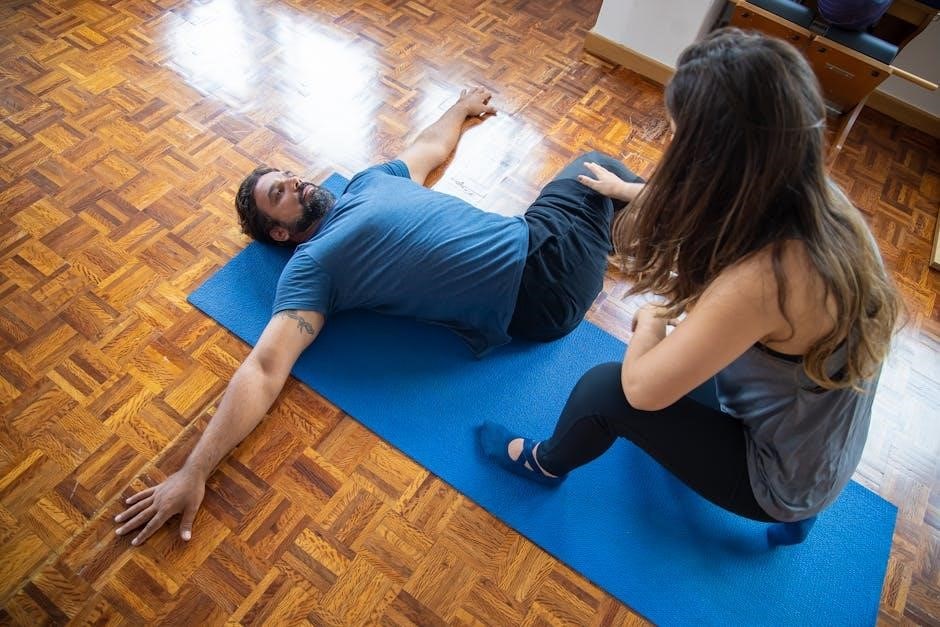ironman 70.3 training program pdf
Embarking on an Ironman 70․3 journey requires a structured training program to ensure success․ This challenging event demands a balanced approach to swim, bike, and run disciplines․
A well-designed plan helps athletes build endurance, strength, and mental resilience․ Whether using free or paid resources, consistency and progression are key to achieving race-day readiness․
Nutrition, recovery, and periodization play crucial roles in optimizing performance․ Start your journey with a clear strategy to maximize progress and avoid overtraining․
1․1 What is an Ironman 70․3?
An Ironman 70․3 is a triathlon consisting of a 1․9km swim, 90km bike ride, and 21․1km run․ It’s half the distance of a full Ironman, making it a popular challenge for athletes seeking to test endurance․ The event attracts both experienced triathletes and newcomers aiming to push their limits in a demanding yet achievable format․
1․2 Importance of a Training Program
A structured training program is essential for Ironman 70․3 preparation․ It helps prevent injuries, builds endurance, and ensures consistent progress․ A well-designed plan guides athletes through swim, bike, and run phases, avoiding overtraining․ It also enhances mental preparation and time management, ensuring a balanced approach to reaching race-day readiness․ A program keeps athletes motivated and focused on their goals․
Understanding the Ironman 70․3 Distance
The Ironman 70․3 consists of a 1․2-mile swim, 56-mile bike ride, and 13․1-mile run․ It is half the distance of a full Ironman, making it a challenging yet achievable goal for many triathletes․
2․1 Breakdown of Each Discipline
The Ironman 70․3 consists of three disciplines: a 1․2-mile swim, 56-mile bike ride, and 13․1-mile run․ Each segment demands specific skills and endurance․ The swim typically occurs in open water, requiring strong strokes and pacing․ The bike ride tests sustained power and cadence on varied terrain, while the run challenges cardiovascular endurance and mental toughness over a half-marathon distance․
2․2 Key Differences from Full Ironman
The Ironman 70․3 is half the distance of a full Ironman, with a 1․2-mile swim, 56-mile bike, and 13․1-mile run․ Unlike the full Ironman, which doubles these distances, the 70․3 is more accessible for athletes seeking a challenging yet manageable event․ Training time, intensity, and recovery requirements are also significantly reduced, making it a popular stepping stone for those aiming to progress to longer distances․

Choosing the Right Training Plan
Selecting a suitable Ironman 70․3 training plan involves considering your fitness level, goals, and availability․ Free and paid options offer structured workouts, ensuring consistency and progression for success․
3․1 Factors to Consider
When selecting an Ironman 70․3 training program, consider your current fitness level, goals, and availability․ Ensure the plan includes progressive overload, recovery strategies, and nutrition guidance․ For beginners, a structured 12-20 week program with strength training is ideal․ Avoid plans that cause overtraining or lack variety․ Choose a plan that balances intensity with rest to optimize performance and sustainability․
3․2 Free vs․ Paid Resources
Free Ironman 70․3 training programs are available but often lack depth and personalization․ Paid plans offer structured schedules, expert guidance, and progressive strategies․ Free resources are ideal for experienced athletes, while paid plans suit beginners or those seeking detailed support․ Choose based on your needs and budget to ensure a comprehensive approach to race preparation and success․
Training Duration and Structure
A typical Ironman 70․3 training program lasts 16-24 weeks, with a structured schedule incorporating base building, intensity phases, and tapering․ This ensures gradual progression and race readiness․
4․1 Overview of Typical Programs
Typical Ironman 70․3 training programs range from 12 to 24 weeks, with structured phases․ Plans often include swim, bike, and run workouts, plus strength training․ A 20-week novice plan focuses on gradual progression, while a 12-week program intensifies preparation․ Matt Fitzgerald’s 16-week plan emphasizes consistency and variety․ Most programs average 7-10 hours weekly, peaking closer to race day, ensuring athletes are race-ready․
4․2 Phases of Training
Training for an Ironman 70․3 typically follows a periodized structure, divided into distinct phases․ The base phase focuses on building endurance and strength, lasting 12-16 weeks․ The build phase (4-8 weeks) increases intensity and specificity․ Finally, the peak and taper phase (2-4 weeks) allows athletes to recover and sharpen race readiness․ Each phase is designed to maximize performance while preventing overtraining․

Building a Strong Base Fitness Level
Establishing a solid base fitness level is crucial for Ironman 70․3 success․ Focus on consistent endurance workouts, gradual progression, and strength building to reduce injury risk and enhance performance․
5․1 Importance of Base Training
Base training is the foundation of any successful Ironman 70․3 program․ It builds endurance, strength, and aerobic capacity, reducing injury risk and improving overall performance․ Consistent aerobic workouts, strength exercises, and gradual progression ensure athletes develop the resilience needed for more intense phases later in training․ A strong base prepares the body for the demands of triathlon, making race day success more achievable․
5․2 Incorporating Consistency
Consistency is vital for building a strong foundation in Ironman 70․3 training․ Regular workouts ensure incremental progress, allowing the body to adapt and recover․ A structured plan with varied yet focused sessions maintains engagement and prevents overtraining․ Over time, consistency fosters mental toughness and physical resilience, essential for enduring the demands of triathlon training and racing․
Swimming for Ironman 70․3
Swimming is the foundation of triathlon training․ Weekly workouts focus on endurance, speed, and technique․ Consistency and progression ensure steady improvement, building confidence for race day․
6․1 Weekly Swim Workouts
A typical week includes 2-3 swim sessions, focusing on endurance, speed, and technique․ Workouts progress from foundational fitness to race-specific skills, ensuring adaptability and performance․ Incorporate drills, intervals, and strength exercises to build efficiency and endurance․ Consistency and periodization are key to achieving swim readiness for the Ironman 70․3 distance․
6․2 Progression Strategies
Swim progression focuses on building endurance, speed, and technique․ Start with foundational workouts, then gradually increase intensity and distance․ Incorporate interval training, strength exercises, and race-pace simulations․ Periodization ensures steady improvement, with deload weeks for recovery․ Consistency and adaptability are key to achieving swim readiness for the Ironman 70․3 distance effectively․
Biking for Ironman 70․3
Biking is a cornerstone of Ironman 70․3 training, requiring endurance, speed, and technique․ Weekly workouts include long rides, intervals, and cadence drills to build strength and efficiency․
7․1 Weekly Bike Workouts
A typical Ironman 70․3 bike training plan includes 3-4 rides per week, focusing on endurance, speed, and technique․ Long rides build stamina, while intervals and cadence drills enhance power and efficiency․ Progression is key, with increasing intensity and distance over time․ Consistency ensures athletes develop the strength and endurance needed for the demanding 56-mile bike segment․
7․2 Progression Strategies
Bike progression involves increasing intensity and endurance gradually․ Start with steady-state rides, then introduce interval training to boost power․ Incorporate strength workouts to improve cadence and efficiency․ Periodically extend ride distances to simulate race conditions․ Recovery weeks are essential to allow adaptation and prevent overtraining․ Consistent progression ensures peak performance by race day․
Running for Ironman 70․3
Running is the final discipline, requiring endurance and consistency․ Focus on building a strong aerobic base with gradual mileage increases to avoid injury and enhance performance․
8․1 Weekly Run Workouts
A typical week includes 3-4 run sessions, balancing endurance, speed, and recovery․ Start with a long slow distance run to build aerobic capacity, followed by interval training to improve speed․ Incorporate a recovery run and a brick workout (run after bike) to enhance race-specific fitness․ Gradually increase mileage and intensity to avoid injury and peak performance․
8․2 Progression Strategies
Progression in run training involves gradually increasing intensity and volume․ Start with base building, then introduce speed workouts and hill repeats․ Incorporate strength training to improve endurance and prevent injuries․ Periodization is key, with phases focusing on building, intensity, and race-specific preparation․ Consistency and rest days ensure adaptation and peak performance on race day․

Nutrition and Recovery Strategies
A balanced diet rich in carbs, protein, and electrolytes fuels performance․ Proper hydration and timing of meals are crucial for endurance and recovery․
Post-workout recovery includes stretching, ice baths, and adequate sleep to repair muscles and enhance adaptation․ Nutrition planning is tailored to individual needs․
9․1 Fueling for Performance
Proper nutrition is vital for optimizing performance in Ironman 70․3 training․ A balanced diet rich in carbohydrates, proteins, and electrolytes ensures sustained energy levels․
- Carbohydrates are the primary fuel source during intense workouts․
- Protein aids in muscle repair and recovery post-training․
- Hydration and electrolyte balance maintain performance and prevent cramps․
9․2 Recovery Techniques
Effective recovery is crucial for Ironman 70․3 success․ Techniques include rest days, stretching, and hydration to replenish lost fluids and electrolytes․
- Post-workout cool-downs and foam rolling aid muscle repair․
- Sufficient sleep ensures physical and mental rejuvenation․
- Active recovery, like light swimming or cycling, promotes blood flow without overexertion․
Periodization of Training
Periodization structures training into phases, enhancing endurance and strength while minimizing injury risk․ It ensures peak performance on race day, building progressively from base to race readiness․
10․1 Understanding Periodization
Periodization is organizing training into specific phases to optimize performance and prevent overtraining․ It involves alternating intense workout periods with recovery phases, allowing the body to adapt and improve efficiently․ This structured approach ensures athletes peak at the right time, enhancing endurance, speed, and overall race readiness progressively․ It’s a cornerstone of successful Ironman 70․3 preparation․
10․2 Sample Periodized Plan
A sample periodized plan for Ironman 70․3 might include a 20-week structure divided into three phases: base building (weeks 1-8), intensity building (weeks 9-14), and race-specific preparation (weeks 15-20)․ Each phase focuses on different aspects of fitness, with the final weeks tapering to ensure peak performance on race day․ Strength training and nutrition are integrated throughout the plan․

Scheduling and Time Management
A typical 20-week Ironman 70․3 plan requires balancing life and training․ Consistency is key, with weekly schedules averaging 7-10 hours․ Avoid overtraining to ensure progress and recovery․
11․1 Balancing Life and Training
Effectively balancing life and training for an Ironman 70․3 requires a structured schedule․ Allocate specific times for work, family, and training, ensuring consistency without overtraining․ Use a planner or app to stay organized and flexible, allowing for unexpected events․ Prioritize rest and recovery to avoid burnout, and maintain relationships by involving loved ones or scheduling family time․ Mental preparation through goal-setting and visualization can enhance resilience and focus during training․
11․2 Avoiding Overtraining
Avoiding overtraining is crucial for long-term success in Ironman 70․3 preparation․ Monitor recovery by tracking heart rate, sleep quality, and muscle soreness․ Incorporate rest days and cross-training to reduce stress on specific muscle groups․ Gradually increase training intensity and volume to allow adaptation․ Pay attention to early signs of overtraining, such as fatigue or decreased performance, and adjust the plan accordingly to prevent burnout or injury․

Mental Preparation and Race Strategy
Mental preparation is vital for Ironman 70․3 success․ Develop a race strategy focusing on pacing, nutrition, and gear․ Build confidence through visualization and positive affirmations to stay focused during the race․
12․1 Building Mental Toughness
Mental toughness is crucial for Ironman 70․3 success․ Techniques like visualization, positive self-talk, and mindfulness can enhance resilience․ Consistent training builds confidence, while embracing challenges fosters a growth mindset․ Learning to stay composed under pressure ensures athletes perform at their best during the race․
12․2 Race Day Strategy
A successful race day strategy involves pacing, nutrition, and mental resilience․ Start with a steady pace, fuel consistently, and stay hydrated․ Transition efficiently and maintain focus․ Course knowledge and equipment preparation are vital․ Stay adaptable to unexpected challenges and draw on mental toughness to push through difficult moments, ensuring a strong finish․